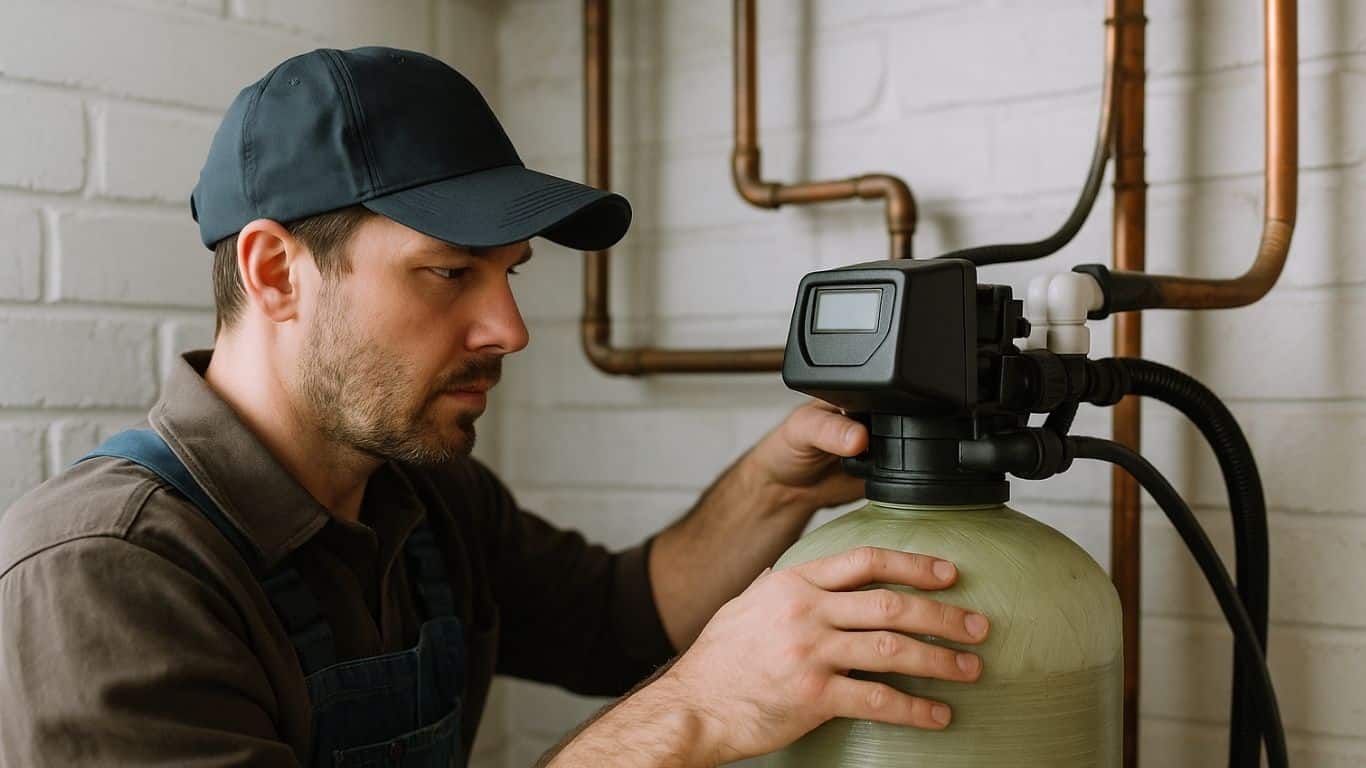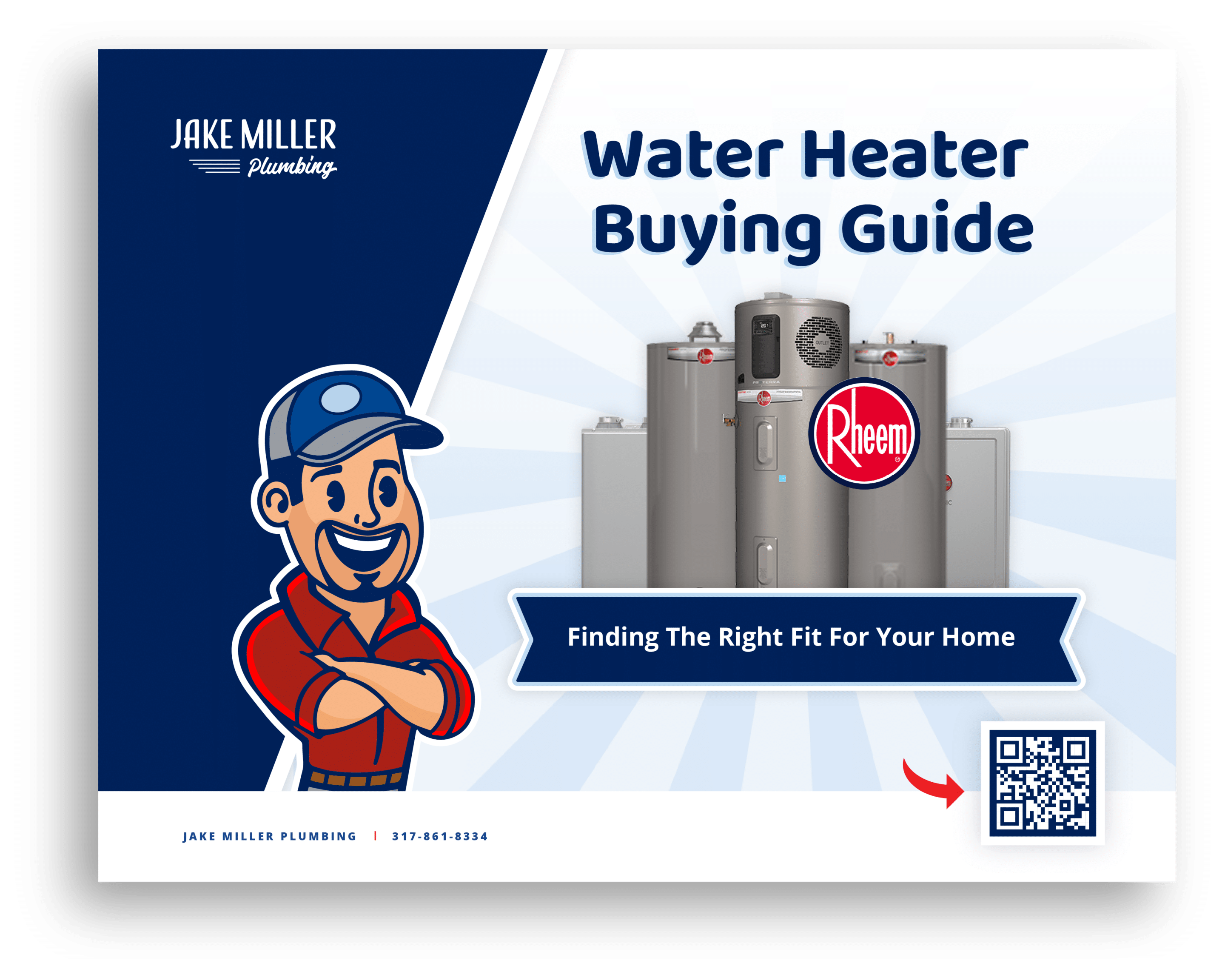A Plumber’s Definitive Guide on How a Water Softener Works
If your home has hard water, you’re intimately familiar with its calling cards. It’s the stubborn white film on your shower door, the spotty residue on your “clean” dishes, and that perpetually dry feeling on your skin. You know the problem, but the solution—a water softener—often feels like a mysterious black box. Water goes in hard, comes out soft. But what happens inside?
At Jake Miller Plumbing, we believe a homeowner who understands their system is a homeowner who can protect their investment. Forget the generic explanations. We’re pulling back the curtain to give you a detailed, plumber’s-level understanding of the fascinating science at work in your home. This is exactly how a water softener works.
The Real Enemy: What Exactly Is Hard Water?
Before we explore the solution, let’s define the adversary. “Hard water” is simply water with a high concentration of dissolved minerals, primarily calcium (Ca2+) and magnesium (Mg2+). In many areas, the local geology is rich in minerals like limestone, meaning the water naturally absorbs these rock-hard elements on its journey to your tap.
While not harmful to your health, these minerals are disastrous for your home. They build up as limescale, constricting pipes, destroying water heaters, and reducing the efficiency of every water-using appliance. They also react with soaps and detergents, creating soap scum and preventing a proper lather, which leads to those frustratingly dull clothes and filmy surfaces.
The Solution’s Secret: A Tale of Two Tanks and Ion Exchange
The magic of water softening isn’t magic at all; it’s a clever chemical process called ion exchange. Your water softener system is typically made of two primary components: the tall, narrow resin tank (or media tank) and the shorter, wider brine tank.
Think of the resin tank as a heavily guarded nightclub. Inside, it’s filled with thousands of tiny, porous plastic spheres called resin beads. These beads are the “bouncers.” To prepare them for duty, they are “charged” by being coated with soft sodium ions (Na+). These sodium ions are the well-behaved guests already inside the club, but they are holding their spots very loosely.
Step 1: The Great Mineral Swap
As hard water from your main line enters the top of the resin tank, it flows down through this bed of charged resin beads. Here’s where the science happens:
- The hard water minerals, calcium and magnesium, carry a strong positive charge (2+).
- The sodium ions coating the resin beads carry a weak positive charge (1+).
The negatively charged resin beads have a much stronger attraction to the potent calcium and magnesium ions than they do to the weaker sodium ions. As the hard water flows past, the resin beads act like powerful magnets, grabbing the calcium and magnesium ions out of the water and holding them tight.
In exchange for every hard mineral ion they grab, the beads release a sodium ion into the water. The troublemakers are pulled out of the line, and the well-behaved guests take their place. This microscopic swap happens millions of times as water passes through the tank. The water that exits the bottom of the tank and flows to your home is now “soft,” free of the damaging minerals.
The “Reset” Button: Understanding the Regeneration Cycle
Eventually, after softening hundreds of gallons of water, the resin beads become saturated. Every available spot is occupied by a captured calcium or magnesium ion, and they can’t hold any more. The system is full. Does this mean it’s time for a new one? Absolutely not. It’s time to clean the bouncers and reset the club. This automatic process is called regeneration.
This is where the second tank—the brine tank—comes into play. The brine tank is what you fill with salt pellets or potassium chloride. When regeneration begins (typically at night, programmed by the system’s control valve), it creates an intensely concentrated saltwater solution called brine.
The regeneration cycle has a few distinct phases:
- Backwash: First, the system reverses the flow of water, flushing the resin tank upward to remove any sediment or debris and to fluff up the compacted resin beads.
- Brine Draw: The super-concentrated brine solution is slowly siphoned from the brine tank and drawn through the resin beads. The sheer force and volume of thousands of sodium ions in the brine are enough to overwhelm the resin. They forcibly knock the captured calcium and magnesium ions off the beads, taking back their original spots.
- Slow Rinse: The displaced calcium and magnesium ions, now floating free alongside the excess brine, are slowly rinsed out of the tank and flushed down a drain line.
- Fast Rinse: A final, faster rinse purges the tank of any remaining brine and ensures the resin beads are properly reset and ready for service.
The entire regeneration process leaves the resin beads sparkling clean and fully recharged with sodium ions, ready to soften your water again. The only thing you need to do is keep the brine tank filled with salt.
Your Local Experts in Water Softening Solutions
Understanding how a water softener works reveals it’s not just a luxury but a crucial defense for your home’s plumbing infrastructure. By actively removing the minerals that cause limescale, you extend the life of your pipes, water heater, dishwasher, toilets, faucets and washing machine, all while enjoying the tangible benefits of softer skin, brighter laundry, and spot-free glasses.
If you’re tired of the endless battle with hard water in your home, our team of experts is here to help. We can test your water’s specific hardness level and recommend a system that’s perfectly sized for your family’s needs. Don’t just live with hard water—eliminate it. Contact us today to schedule your consultation.
How Does a Water Softener Work? Your Top Questions Answered
Understanding the process is the first step, but it often leads to more practical questions. Here are the answers to the top 5 questions we hear from homeowners after they learn how a water softener works.
1. Will a water softener make my water taste salty?
This is the most common myth we debunk. The answer is no. While the system uses salt to create a brine solution for cleaning the resin beads, that highly concentrated saltwater is completely flushed out of the system during the regeneration cycle. The only thing added to your water is a minuscule amount of sodium through the ion exchange process itself—typically less sodium than you’d find in a single slice of white bread. Most people cannot taste any difference at all.
2. What is the difference between using salt and potassium chloride?
Sodium chloride (salt) is the standard, most cost-effective option for regenerating a water softener. It’s highly efficient and readily available. Potassium chloride is a salt-free alternative that works in the same way but releases potassium ions instead of sodium ions. While it is more expensive, some homeowners prefer it if they are on a strictly sodium-restricted diet or wish to use the soft water for watering plants and gardens, as potassium is a vital nutrient for soil.
3. How often do I need to add salt to the brine tank?
This depends entirely on three factors: the hardness of your water, your household’s daily water consumption, and the size of your brine tank. For an average family of four with typical water hardness, you can expect to add a new bag of salt every 6 to 8 weeks. However, modern high-efficiency systems may use less. We recommend checking the salt level in your brine tank once a month to be safe.
4. Is a water softener the same as a water filter?
No, they perform two very different but complementary jobs. A water softener is designed specifically to remove hardness minerals (calcium and magnesium) to protect your plumbing and appliances from limescale. A water filter is designed to remove contaminants that affect taste, smell, and safety, such as chlorine, sediment, pesticides, or bacteria. They can be used together in a whole-home system to provide water that is both soft and purified.
5. What size water softener do I need for my home?
Sizing is critical for efficiency and is not a one-size-fits-all calculation. An undersized unit will regenerate too often, wasting salt and water, while an oversized unit can be inefficient. Proper sizing depends on two key numbers: your water’s hardness level (measured in Grains Per Gallon, or GPG) and your household’s average daily water usage. This is why professional water testing and a consultation are essential to ensure you invest in a system that is perfectly tailored to your home’s specific needs.

